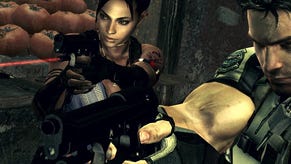Face-Off: Resident Evil 5
Not quite black and white.
Resident Evil 5 might not be quite the gaming masterpiece we were hoping for, but there are still plenty of reasons you should consider adding it to your gaming arsenal: excellent visuals, Resi 4-esque gunplay love, and a hugely enjoyable online co-op mode. The good news is that both Xbox 360 and PS3 games are worth serious consideration, but only one version will emerge triumphant from the uncompromising scrutiny of the Eurogamer Thunderdome. [I don't remember sanctioning a Thunderdome. - Ed]
The technology behind Resident Evil 5 is Capcom's very own Framework MT engine, which debuted on Xbox 360 as the workhorse behind Dead Rising. However, its earliest origins go back further to the Onimusha 3 era on PlayStation 2. Due to a series of presentations made at CEDEC 2006, reported in depth by the Japanese press and translated on the invaluable Beyond3D forum, we actually know quite a lot about this technology. For example, the MT stands for Multi-Target, Meta Tools and Multi-Threaded. And, amazingly, fewer than ten developers at Capcom's Japanese HQ created it.
Game development work starts on PC, and from there the code is easily ported to either the Xbox 360 or PlayStation 3, where platform-specific optimisations are coded in. The advantage of Framework MT is that although the focus is on console, Capcom also gets a PC version effectively for 'free'. This is a barebones version though, used for reference, and requires quite a lot of additional work before being ready for release as a commercial product - which may explain, in part, why we have to wait a while yet until Resident Evil 5 hits PC.
From official figures released at CEDEC by the developer, we also know a fair amount about the performance of the engine too. Each frame is comprised of between three and four million polygons, meaning a peak throughput of an astonishing 120m polygons per second. What's more, those stats date back to 2006, meaning there's every chance that Capcom has since improved and refined upon the technology. It's also worthwhile noting that the PS3 version of the engine only began development around a year after the 360 version was up and running.
Its cross-platform performance has been somewhat variable. Devil May Cry 4 scaled back a lot of Framework MT's effects in order to make 60fps viable (the technology is designed primarily for 30fps games) and it's one of the closest conversions we've seen. However, Lost Planet suffered pretty badly on PS3, exhibiting poorer visual quality and a decidedly lower frame-rate - despite arriving a year after its 360 sibling.
Capcom has clearly learned a lot of lessons since then, as initial impressions of Resident Evil 5 aren't bad at all, as you can see in the video below. As usual, the action's been slowed down to retain detail, and cropped so that one pixel in the Eurogamer player equates to one pixel on your HDTV. In addition, as is the norm with the Eurogamer face-off coverage, there are full range 24-bit RGB grabs purloined from the HDMI ports of both consoles. Go check them out in our Resident Evil 5 comparison gallery. There's also more video love at the Digital Foundry blog.
Right off the bat, it's worth saying that Resident Evil 5 on PS3 is a much more impressive conversion than Lost Planet, but it does still share some of its shortcomings: the frame-rate is lower on stressful scenes, there are a few missing special effects, and in common with all the previous games based on the same platform, it requires a big install. In this case, a whopper 4.8GB of your hard drive, taking ten minutes to transfer from the Blu-ray disc, up against the optional 6.7GB of the NXE installed 360 version.
Smoothing off the Edges
Capcom's Framework MT engine uses some very useful tricks in maintaining image quality. It runs at native 720p, and employs the use of full-on 4x multisampling anti-aliasing on Xbox 360, while using the 2x Quincunx technique on PS3. On a like-for-like basis, this means that the 360 has clearer visuals (2x QAA blurs every texture) but edge-smoothing is very similar. The cleverness kicks in when the engine is stressed. Rather than drop frames, the engine tones down the anti-aliasing instead. According to Capcom's own figures, this can result in a 20 per cent performance boost when the game needs it. The idea here is that the gameplay is sufficiently intense that you won't notice a momentary reduction in edge-smoothing. So on Xbox 360, it's reduced from 4x down to 2x, before being removed completely. On PS3, however, the Quincunx effect is either on, or off.
As it happens, Killzone 2 uses exactly the same technique. However, things are slightly odd on the PS3 version of Resident Evil 5 in that the anti-aliasing can turn on and off again at any given point, seemingly when the engine seemingly isn't being stressed at all. In fact, it happens right at the beginning of the game, as the next video demonstrates. First you'll see the gameplay in typical 1:1 pixel mode, then we'll zoom in 200 per cent. Look at the rooftop and the palm tree in particular and witness the AA turn on and off in quick succession on what is a relatively painless scene.
Resident Evil 5 pushes the engine far more than its cross-platform predecessors on the Framework MT platform, so while we expect an impact on performance, it's rather bizarre than such an obvious effect like this should have made its way into the final code. For its part, Xbox 360 behaves exactly as it should, although it is not without its own visual compromises, which we'll get to later.









